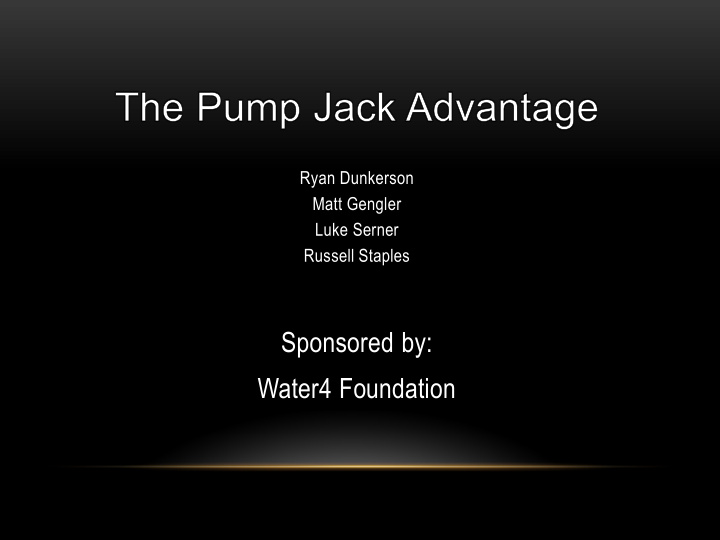



Ryan Dunkerson Matt Gengler Luke Serner Russell Staples Sponsored by: Water4 Foundation
• Eradicate the world's water crisis. • Water4 uses inexpensive materials and easily-transferable technology • Training, equipping and supporting nationals to be the solution to their own community's water needs.
• System that can be used by handicapped people and small children without assistance from others • Ensure it can be continually improved • The go to system for all manually pumped water wells.
• 176 gallons/day vs. 5 gallon/day. 1 • 37% of people on the African continent currently live in a water-scarce environment. 2 • 115 people in Africa die every hour from poor sanitation, poor hygiene, and contaminated water. 3 • ¼ of the population spends at least half an hour per trip to collect water. 3
Figure 1
• Build a pump jack with a mechanical advantage • Pumps water on the downstroke • Make pump system more accessible
• Materials must cost less than $150 • Must be able to be built and repaired with materials and tools in the region • Anchored to a 3 foot diameter concrete pad • A flow rate of 4 GPM or higher.
• Must be capable of being operated by handicap people and young children • 2:1 mechanical advantage • Ex: Instead of requiring 40 lb f , only 20 lb f will be needed
• Working Prototype • Test Stand • Instructions for Assembly • Bill of Materials • Drawings • SolidWorks Parts and Assemblies • Recommendations for Future Improvement
• Most mechanically advantaged pump jack patents had expired by early 1900s, eliminating possible design conflicts
Water4 Pump India Mark II
Village Level Location of Capacity Corrosion Operation Origin or Name Type (gal/min) Resistant and Successful Maintenance Use Suction- Swiss Pedal 15.9 Yes Yes Cambodia treadle India Mark Piston 3.17 No No India II Water4 Piston 4.0 Yes Yes Africa Pump Table 1
• F 1 D 1 = F 2 D 2 • F: Force (lb f ) • 𝑚, 𝐸 : Length (in) 𝐺 1 𝐺 2 = Ratio • • E: Modulus of Elasticity (psi) • I: Moment of Inertia (in 4 ) • 𝜀 = 𝐺𝑚 3 • 𝜀 : Deflection (in) 3𝐹𝐽
• F 1 D 1 = F 2 D 2 For Lever Arm • Known Values F 1 = 40 lb f D 1 = 12.0” D 2 = 26.5” • F 2 = 18.1 lb f • 𝐺 1 = 2.2 𝐺 2 • Mechanical Advantage of 2.2:1
• 𝜀 = 𝐺𝑚 3 3𝐹𝐽 For Lever Arm
Weight Calculations Weight (lbs) Prototype 1 Prototype 2 Horse's Head 15.5 8.4 Rack 6.2 4.6 Square Tubing 85.4 63.1 Sleeve Bearings 0.8 0.9 Round Stock 5.3 6.8 Washers 0.8 0.7 Cotter Pins 0.06 0.05 Galvanized Nipple 1.7 1.7 Roller 1.5 1.5 Roller Mounting Plates 2 2 Total 119.26 89.75
1/4" plate steel $50.00 1 2" Square Tubing $61.60 2 Galvanized Nipple $7.54 S Misc. Materials $30.00 Pi W Co G Total $149.14 T
Prototype 1 Prototype 2 1/4" plate steel $50.00 1/4" plate steel $31.25 2" Square Tubing $61.60 1.5" Square Tubing $47.04 Sleeve Bearings $44.20 Sleeve Bearings $44.20 Pins 3/4 hot rolled round stock $4.75 Pins 3/4 hot rolled round stock $4.28 Washers $4.60 Washers $4.60 Cotter Pins $5.10 Cotter Pins $5.10 Galvanized Nipple $7.54 Galvanized Nipple $7.54 1" pipe $0.17 1" pipe $0.17 Total $177.96 Total $144.18
• After 24 hours of testing, system did not show significant wear and operated well when attached to the electric motor. • The pulley system kept the rack aligned.
Downstroke: 𝐺 1 • F 1 = 40 lb f F 2 = 12 lb f 𝐺 2 = 3.3 • Mechanical Advantage of 3.3:1 Upstroke: 𝐺 1 • F 1 = 22 lb f F 2 = 13 lb f 𝐺 2 = 1.7 • Mechanical Advantage of 1.7:1
• Design goals were achieved • The 2:1 mechanical advantage for the downstroke was exceeded by a 3.3:1 ratio • The 2:1 advantage can be met on the upstroke with counterbalance but it will require more down force • Construction of design was completed under budget by $5.82 • We limited the stroke to 12 inches for optimum performance • A flow rate of at least 5 GPM was maintained at 44 strokes/min • Moves the pump handle off of the edge of the concrete pad
• Paint the system • Lubrication • Bolt on horse’s head • Wrap inner portion of the pulley with a piece of tire inner tube • Further wear testing
• Wayne Kiner and the BAE Lab Staff • Dr. Marvin Stone • Steve Stewart (Inventor of Water4 System) • Water4 Staff • Dr. Paul Weckler • Dr. Daniel Thomas
• 1 http://www.waterinfo.org/resources/water-facts • 2 http://www.unwater.org/downloads/nepadwater.pdf page 2 • 3 http://www.un.org/waterforlifedecade/africa.shtml • Figure 1: http://www.water4.org/a-global-problem/water-scarcity/ • Water4.org Google Patents • Tamele, C (2007). Improving Appropriate Technologies For Small Scale Irrigation in Semi- • Arid Areas: A Case Study on Mabote District of Mozambique. M.S. Thesis Table 1: Stewart, E. (2003). How to select the proper human-powered pump for potable water. In D. • o. C. a. E. Engineering (Ed.), CE 5993 Field Engineering in the Developing World . Michigan: Michigan Technological University. Available at www.cee.mtu.edu.
Recommend
More recommend